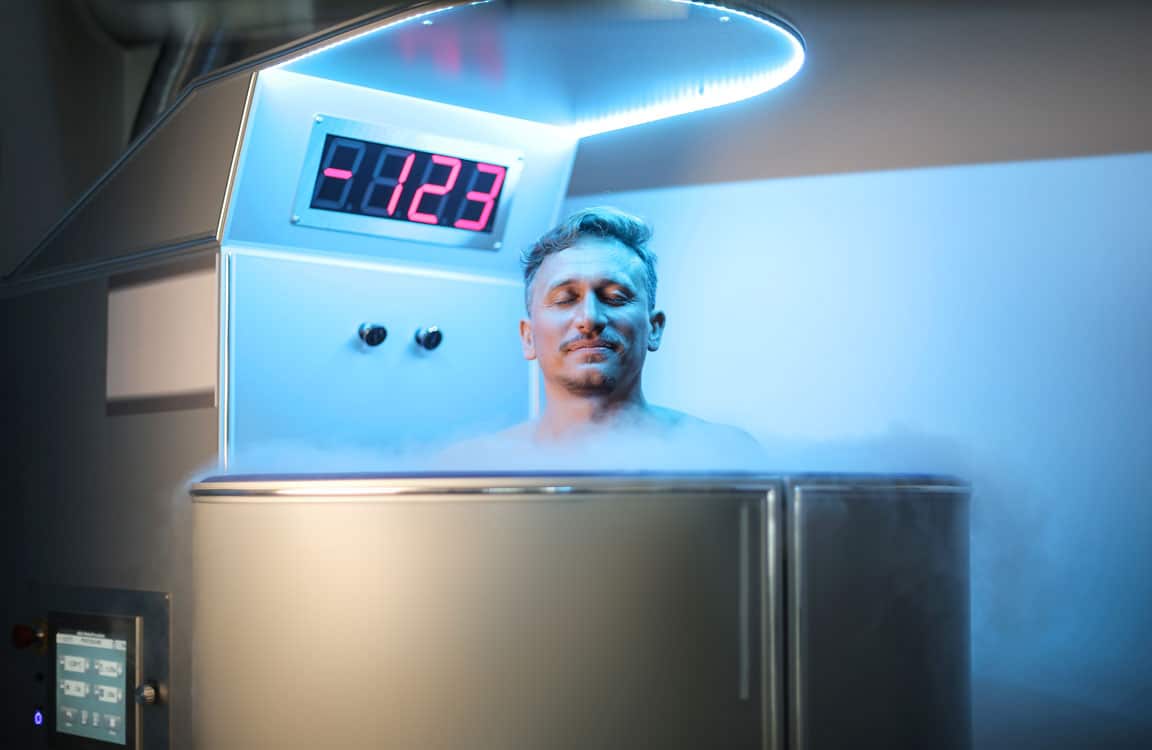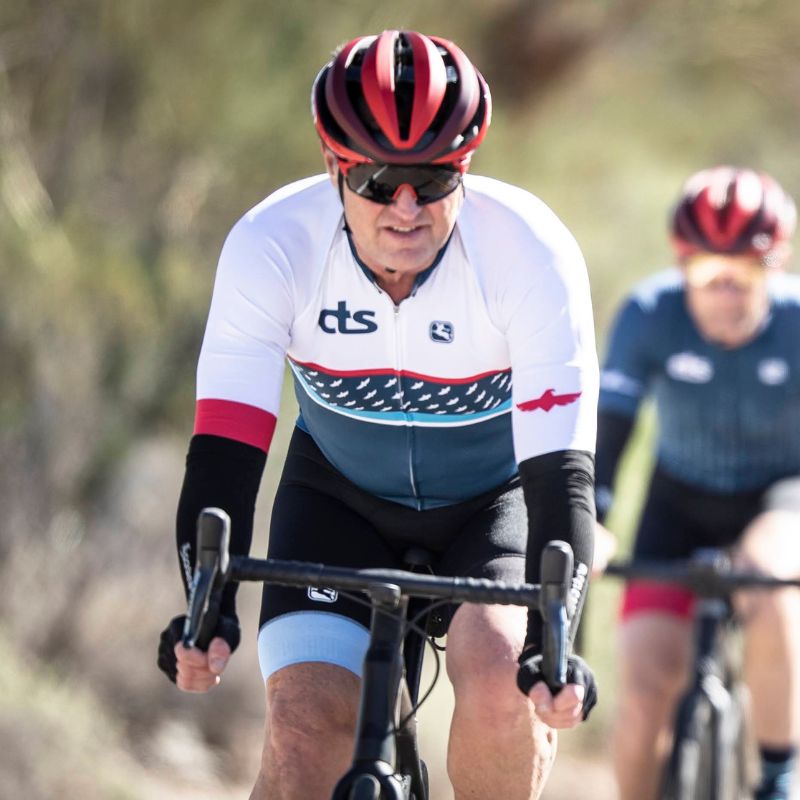
Will Cryotherapy Improve Recovery for Cyclists?
By Chris Carmichael
Founder and Head Coach of CTS
Does standing in a supercooled environment for 2-3 minutes provide meaningful recovery benefits for cyclists? Whole body cryotherapy (WBC) is a recovery modality some athletes and cycling teams have added to their post-workout routines, but does it work?
How Cryotherapy Works
To experience WBC you need access to a chamber where you are exposed to temperatures between -110 to -140 degrees Celcius (-160-220 Fahrenheit) for up to 3 minutes. First, you enter an antechamber at -60 degrees C (-76 F) for about 30 seconds, and then pass to the cryochamber. To avoid the risk of damaging your skin, you have to be completely dry before treatment (no sweat).
The short-term exposure to extreme cold rapidly reduces skin temperature. However, the effects of WBC go far beyond cooling the skin, and may trigger changes in inflammatory response, hormone levels, pain perception, and more. The question is whether these changes are meaningful for endurance athletes, and whether you can achieve the same benefits from lower-tech methods.
Core Temperature
Cryotherapy has a similar effect on core temperature as immersion in very cold water. Initially, skin temperature drops significantly but core temperature doesn’t change much at all. Upon exiting the cold environment and rewarming, people experience “afterdrop”. Vasolidation in the skin and extremities mixes colder blood with the warmer blood from your body’s core – lowering core temperature. In the case of cryotherapy, a recent study found core temperature did decrease – but about 50-60 minutes after treatment. (Zalewski, 2014)
Parasympathetic Nervous System Activation
Strenuous exercise ramps up the sympathetic (fight or flight) nervous system, leading to increased heart rate and blood pressure, among other things. The recovery process after exercise depends partly on the activation of the parasympathetic nervous system to put the brakes on your racing heart. Exposure to cold, as with WBC or cold water immersion, causes peripheral vasoconstriction, which increases blood pressure centrally. This triggers the baroreflex, which kick starts the parasympathetic nervous system to bring heart rate and blood pressure down. (Zalewski, 2014; Louis, 2015)
Feel Stronger in 6 Weeks — No Matter Your Age
Climbs feel steeper? Recovery slower?
You’re not done getting faster — you just need a smarter plan.
The 6-Week Masters Power Build Coaching Program is designed for cyclists 50+ who want to boost power, recover faster, and ride stronger — all with expert 1:1 coaching.
- Personalized 6-Week Training Plan
- 1:1 Coaching + TrainingPeaks Premium
- Mobility & Strength Bonus Guides
💪 Guarantee: Stronger or free.
Start your 6-week journey for $149Inflammation
One of the primary selling points for cryotherapy is the claim that it reduces inflammation. Indeed, according to recent review studies (Bleakley, 2014; Lombardi, 2017), there is evidence WBC enhances an athlete’s cytokine profile by reducing pro-inflammatory cytokine production. However, multiple sessions are needed to achieve beneficial results.
Stress hormones
While research shows WBC can reduce blood levels of the stress hormones, it only appears to do so after multiple days of training and multiple WBC treatments. For example, one study (Wozniak, 2013) with elite rowers training twice per day found that cortisol levels increased after three days in the control group, but WBC (also twice a day) delayed the increase to Day 6 for the WBC group. These results were similar to other research cited in review studies (Lombardy, 2017; Bleakley, 2014).
Muscle soreness, pain relief
Both WBC and CWI have an analgesic effect for athletes following strenuous workouts, and multiple studies examined in the aforementioned review studies showed reductions in pain perception and muscle tiredness, as well as improvements in sleep quality and overall quality of life. A study focusing on Olympic-level synchronized swimmers found WBC treatments after workouts improved sleep quality and duration during an intense period of training, potentially due to cold-induced parasympathetic nervous system reactivation. (Schaal, 2015).
So… yes or no?
From the available research, WBC appears to be an effective recovery tool overall, although there’s still plenty of debate about which aspects of recovery it affects positively. Virtually all the research agrees, however, that it is a safe process as long as it is conducted in a professional setting. The small chances WBC could have a negative effect on recovery or training progress come from potentially mitigating inflammation necessary for the physiological adaptation to training.
However, the biggest reasons I have for shrugging my shoulders at cryotherapy are cost and the fact researchers concluded cold water immersion and/or ice packs were about as effective as WBC for promoting recovery. Remember, WBC was only effective when used frequently and regularly. A single treatment had little to no benefit, and in some cases 20-30 were needed to experience significant benefits.
If you want to use whole body cooling as a recovery tool, the low tech methods appear to be more accessible and cost effective.
► Free Cycling Training Assessment Quiz
Take our free 2-minute quiz to discover how effective your training is and get recommendations for how you can improve.
References
Bleakley, Chris, et al. “Whole-Body Cryotherapy: Empirical Evidence and Theoretical Perspectives.” Open Access Journal of Sports Medicine, 2014, p. 25., doi:10.2147/oajsm.s41655.
Lombardi, Giovanni, et al. “Whole-Body Cryotherapy in Athletes: From Therapy to Stimulation. An Updated Review of the Literature.” Frontiers in Physiology, vol. 8, 2017, doi:10.3389/fphys.2017.00258.
Louis, Julien, et al. “Head Exposure to Cold during Whole-Body Cryostimulation: Influence on Thermal Response and Autonomic Modulation.” Plos One, vol. 10, no. 4, 2015, doi:10.1371/journal.pone.0124776.
Schaal, Karine, et al. “Whole-Body Cryostimulation Limits Overreaching in Elite Synchronized Swimmers.” Medicine & Science in Sports & Exercise, vol. 47, no. 7, 2015, pp. 1416–1425., doi:10.1249/mss.0000000000000546.
Wozniak, Alina, et al. “– Sports Medicine Whole-Body Cryostimulation and Oxidative Stress in Rowers: the Preliminary Results.” Archives of Medical Science, vol. 2, 2013, pp. 303–308., doi:10.5114/aoms.2012.30835.
Zalewski, Pawel, et al. “Whole-Body Cryostimulation Increases Parasympathetic Outflow and Decreases Core Body Temperature.” Journal of Thermal Biology, vol. 45, 2014, pp. 75–80., doi:10.1016/j.jtherbio.2014.08.001.
► FREE Mini-Course: Learn How to Maximize Your Limited Training Time
Learn step-by-step how to overcome limited training time and get faster. Walk away with a personalized plan to increase your performance.
"*" indicates required fields


Comments 2
I think there’s a less expensive way to enhance mitochondria power recovery. I’m no expert by any stretch of the imagination, but I’m into bio hacking. From what I’ve learned, a daily shower that you end by putting the faucet on COLD and aiming it at your forehead and building the time up to ONE MINUTE creates apoptosis. It takes 3-4 days to get over the initial shock:) The changing ‘extreme’ temperature creates stress to mitochondria and kills off the week ones and gives the strong ones space to flourish. This affects primarily our brain which takes more energy and power in our body than anything else. I do not have references. Strong mind. Strong body. Check out Dave Osprey, ‘Game Changers’.
This is both short term and long term stuff. On a dime.
“The small chances WBC could have a negative effect on recovery or training progress come from potentially mitigating inflammation necessary for the physiological adaptation to training.”
I think this sentence says it all.. Wer’e looking exactly for long term adaptation to training.
In competition, it’s a completelly different thing, where, when competing in multiday events, we’rre looking for the best and faster recovery possible for next day performance, instead of long term adaptation.
I’m sorry for my english, but am i wrong ?